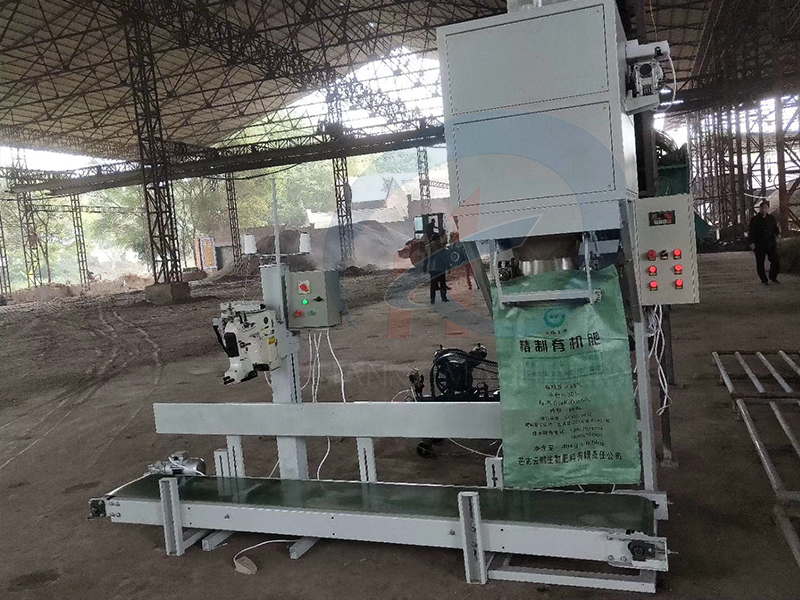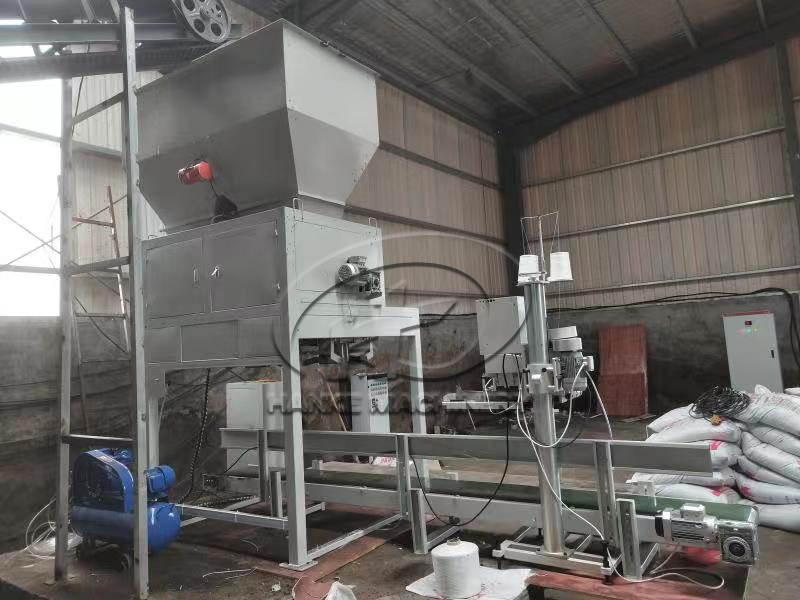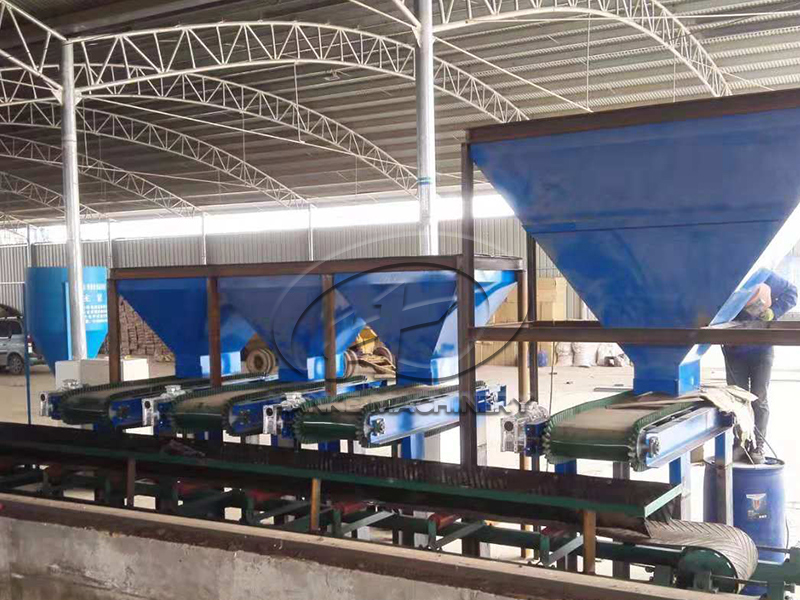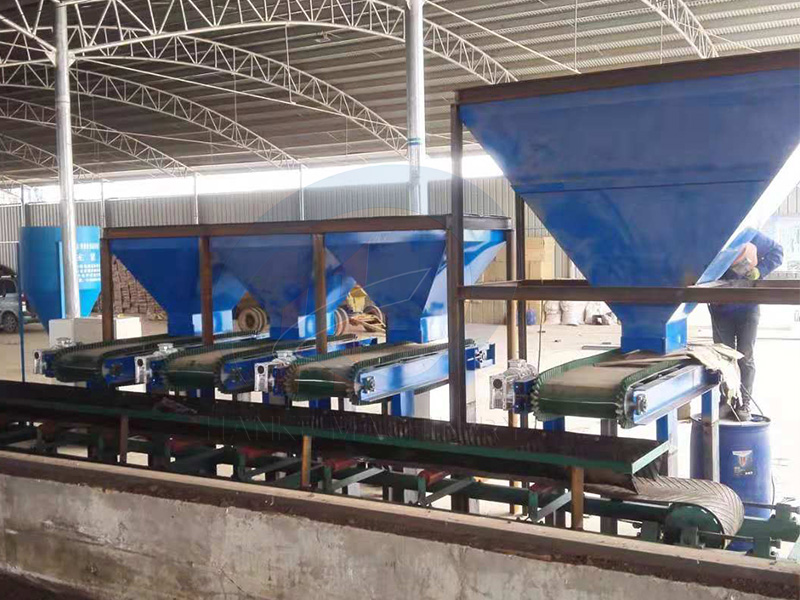Update time : 2025-08-25 Publisher:Zhengzhou Hanke Machinery
The accuracy of the slow-release compound fertilizer filling machine directly determines the measurement accuracy of the product (such as the error range of 25kg/50kg packaging), and the accuracy is affected by multiple factors in four dimensions: material characteristics, core equipment configuration, operating environment, and operation and maintenance. The following is an analysis of the specific influencing factors and their mechanisms of action to help avoid accuracy deviation problems in a targeted manner:
I. Core Influencing Factors: Material Characteristics of Slow-release Compound Fertilizer (Root Cause Factors)
Slow-release compound fertilizers, due to the addition of slow-release coatings, additives or special granular shapes, have a much greater impact on filling accuracy than ordinary fertilizers. They are the "primary cause" of accuracy deviations.
1.Differences in material fluidity
If the controlled-release fertilizer particles are uniform, the surface is dry (without moisture absorption), and the fluidity is good, they can stably pass through the discharge port when discharging, with small measurement errors.
If the particles contain a lot of dust, have a sticky surface (the sustained-release coating is not fully cured), or are of uneven size (such as some small particles in lumps), it will lead to "the feeding speed being fast and slow alternately" - in mild cases, it may result in "overfeeding" or "underfeeding", and in severe cases, it may cause the feeding port to be blocked, directly leading to measurement errors (for example, the packaging error of 50kg bags can reach ±1kg or more).
2. Moisture Absorption and Agglomeration of Materials
If slow-release compound fertilizers are not stored properly and absorb moisture, they are prone to "slight caking" (particles adhering to form small lumps).
When lumpy materials enter the storage bin, they may form a "bridge" (lumpy accumulation that does not discharge) at the bottom of the bin, resulting in the actual discharge volume being less than the set value.
If the lumps are forcibly pushed into the discharge port, they may clog the spiral blades or the gravity discharge channel, causing a sudden increase in the single filling volume (for example, if it was originally supposed to fill 50kg, but due to the blockage, it suddenly discharges and actually fills 52kg).
3. Fluctuation of material density
Due to differences in production processes (such as varying amounts of slow-release agents added), some slow-release compound fertilizers may have "density fluctuations between batches" (for example, the density of one batch is 1.2g/cm³, while that of another batch is 1.3g/cm³).
If the filling machine adopts "volume measurement" (by discharging with a fixed volume), changes in density will directly lead to "weight deviation" (for the same volume, a higher density results in excess weight, while a lower density leads to insufficient weight).
Even for weight-based filling machines, if the density fluctuates too much and the discharge speed is not adjusted accordingly (for example, high-density materials are still discharged at a fast speed), it is prone to "material surging" (the material falls rapidly and impacts the weighing sensor, causing inaccurate instantaneous readings).

II. Key Influencing Factors: Core Configurations and Design of Filling Machines (Equipment Level)
The hardware configuration and structural design of the filling machine are the "core guarantee" for the stability of accuracy. Defects or improper selection of the following components will directly lead to accuracy deviations:
1.Accuracy and Installation of Load Cells
The weighing sensor is the "precision core" of the weighing filling machine, and its performance and condition directly affect the measurement result.
Insufficient sensor accuracy: If low-precision sensors (such as those with an error of ±0.5%) are selected, even if other configurations are perfect, the industry requirement of ±0.1% cannot be met.
Improper installation: If there is a "gap", "tilt" or "vibration interference" (such as vibration from the machine body being transmitted to the sensor) between the sensor and the weighing platform, it will cause reading drift (for example, when the same batch of materials is weighed multiple times, the reading difference can reach 50g or more).
Overload damage: If the material exceeding the rated weight is frequently filled (for example, if the sensor is rated at 60kg but 65kg is filled for a long time), it will cause the linearity of the sensor to decline and the accuracy to gradually deteriorate.
2. Design and Control of the Material Cutting Mechanism
The discharging mechanism determines how the material "stably enters the weighing container". An unreasonable design can lead to "unstable discharging quantity".
Unsegmented speed control: If only "single-speed feeding" (fast feeding throughout the process) is used, when the material approaches the set weight, it is prone to "inertial overfeeding" (the material continues to fall), resulting in weight deviation. High-quality equipment should have "two-speed / three-speed control" (fast feeding at the beginning, slow feeding at the end to make up for the material, reducing the impact of overfeeding).
Poor adaptability of spiral blades: For slow-release fertilizers that tend to form lumps, if the gap between the spiral blades is too large (for example, the gap between the blade and the material tube is > 5mm), it will lead to "material leakage" (the material leaks out from the gap and is not included in the weighing); if the blade rotation speed is too fast, it is easy to break the slow-release coating and at the same time cause uneven material discharge.
3. Configuration of the silo and the arch-breaking device
Whether the structure of the silo and the arch-breaking device are compatible determines whether the material can be discharged "continuously and stably".
The angle of the silo is unreasonable: the cone angle at the bottom of the silo is too small (e.g., < 60°), which easily leads to material accumulation on the silo wall, gradually slowing down the discharge speed, resulting in "the weight of the first few packages is normal, but gradually becomes lighter later on".
No arch-breaking device or poor performance: For materials prone to caking, if no "pneumatic vibration arch-breaking" or "stirring arch-breaking" device is equipped, the material bridge cannot be cleared in time after it forms, which may lead to interruption of discharge or fluctuating discharge volume.
Unstable material level in the silo: Frequent fluctuations in the amount of material in the silo (such as frequent material interruptions followed by replenishment) can cause pressure changes within the silo, which in turn affects the discharge rate (higher material level leads to greater pressure and faster discharge; lower material level results in less pressure and slower discharge), resulting in weight variations for products in the same batch.
4. Stability of the Control System
The control system (PLC + software algorithm) is the core of "precision calibration and error correction". If there are defects, it will lead to loss of precision control.
Slow response of PLC: When the material approaches the set weight, if the PLC cannot quickly instruct the discharging mechanism to "slow down / stop", it will cause "overshoot" (excessive discharging).
No automatic calibration function: After long-term use, the sensor may experience accuracy drift. If the device does not support "timed automatic calibration" or "manual calibration is inconvenient", it will lead to error accumulation (for example, the monthly error expands from ±0.1% to ±0.5%).
Software algorithm defect: The "make-up material algorithm" on some low-end devices is unreasonable (for example, the make-up material quantity is fixed and not dynamically adjusted according to the actual material discharge deviation), which may lead to "insufficient make-up material" or "excessive make-up material".
III. Environmental Factors: Temperature, Humidity and Vibration in the Production Site
Although the on-site environment does not directly determine the accuracy of the equipment, it can indirectly cause accuracy deviations by "affecting material properties" or "interfering with equipment operation".
1.Excessive temperature and humidity
Excessive humidity (such as a relative humidity in the workshop > 80%): Slow-release compound fertilizers are prone to absorbing moisture and forming lumps. At the same time, it may cause the sensor connection terminals to become damp, resulting in signal interference (unstable readings).
Sudden and drastic temperature fluctuations (such as a temperature difference of more than 15℃ between day and night in the workshop): Metal material silos and weighing platforms will slightly deform due to thermal expansion and contraction, changing the force state of the sensors and causing accuracy drift (such as weighing lighter at high temperatures and heavier at low temperatures).
2. On-site vibration interference
If there are "high-power equipment" (such as crushers, fans) near the filling machine, the vibration generated during their operation will be transmitted to the body of the filling machine, causing the weighing sensor to "misread" (counting the force generated by the vibration as the weight of the material), resulting in "significant differences in multiple weighing readings of the same package of material".
Uneven ground or unstable frame: During operation, the filling machine will generate slight vibrations by itself. If the ground is uneven or the frame is not fixed (such as loose anchor bolts), the vibration amplitude will increase, further magnifying the precision deviation.
IV. Operation and Maintenance Factors: Human Operation and Equipment Maintenance (Controllable Factors)
Improper human operation or lack of maintenance are common causes of "equipment accuracy degradation" or "short-term accuracy out of control".
1.Improper operation
Calibration not performed in accordance with procedures: If the material batch is changed or the packaging weight is adjusted, and the "zero point calibration" or "full scale calibration" is not carried out in a timely manner before starting production, it will lead to accuracy deviation.
Improper manual intervention: The semi-automatic filling machine requires manual assistance for bagging / placing cans. If the container is not placed accurately at the weighing center by hand (for example, the bag is not fully aligned with the discharge port, causing some material to spill out), or if the filling is manually ended before the weighing is stable, it will lead to inaccurate measurement.
Parameter setting error: Incorrectly modifying key parameters such as "discharge speed" and "make-up material quantity" in the PLC (for example, changing slow make-up material to fast make-up material) directly led to accuracy deviation.
2. Lack of maintenance and upkeep
Dust and oil accumulation on sensors: After long-term use, if the surface of the weighing sensor accumulates material dust or oil, it will add extra weight, causing "zero drift" (the reading is not 0 when the scale is empty, but shows "+20g", ultimately resulting in each package being 20g overweight).
Wear of vulnerable parts without replacement: After the wear of vulnerable parts such as the spiral blades and the sealing ring of the discharge port, problems such as "material leakage" and "uneven discharge" may occur (for example, if the blades are worn, the local discharge volume will decrease).
Failure to clean the storage bin in a timely manner: The old materials (such as different batches of slow-release fertilizers) remaining in the storage bin form lumps and mix with the new materials, resulting in uneven material properties and indirectly affecting the accuracy.
Summary: How to avoid factors affecting precision?
Material end: Ensure that the storage environment for slow-release compound fertilizers is dry (relative humidity < 60%) to prevent caking; when changing batches, test the material flowability in advance and adjust the equipment discharge parameters if necessary.
On the equipment side, it is recommended to prioritize the configuration of "high-precision strain gauge sensor + dual-speed feeding + pneumatic arch-breaking", ensuring that the silo angle is ≥ 60°, and reserving the function of automatic calibration.
Environmental end: Keep the filling machine away from vibration sources. Maintain stable temperature and humidity in the workshop (temperature 15-30℃, humidity 40%-60%), and ensure the ground is flat and the machine frame is fixed.
The operation end: Develop standardized operation procedures (such as calibration must be carried out after material replacement), regularly clean sensors and material bins, and replace vulnerable parts according to the cycle (such as checking the spiral blades every 3 to 6 months).
By precisely controlling the above factors, the accuracy of the slow-release compound fertilizer filling machine can be stabilized at ±0.1% to ±0.3%, meeting industry standards and user requirements.

see details +

see details +

see details +

see details +

 Tel:+86 17319777703
Tel:+86 17319777703
 E-mail:hkautomaticpack@foxmail.com
E-mail:hkautomaticpack@foxmail.com
 Address:Xingyang City, Zhengzhou City, Henan Province.
Address:Xingyang City, Zhengzhou City, Henan Province.
Privacy Policy Copyright © Zhengzhou Hanke Machinery Equipment Co., Ltd Co., Ltd.